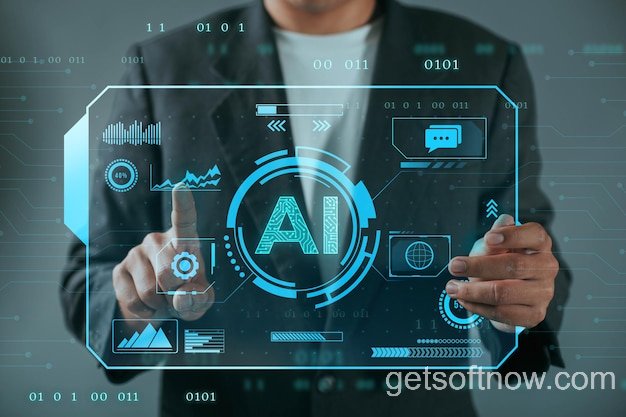The world of software development is undergoing a seismic shift, and the driving force behind this transformation is the emergence of AI building software. This groundbreaking technology is poised to redefine the way we create and develop applications, promising to streamline processes, enhance efficiency, and unlock new realms of innovation.
The Evolution of Software Development
From the early days of punch cards and assembly languages to the modern era of object-oriented programming and agile methodologies, the software development industry has witnessed remarkable advancements. However, traditional approaches have often been plagued by challenges such as time-consuming manual coding, error-prone processes, and the complexity of maintaining consistent quality across large codebases.
What is AI Building Software?
AI building software is a cutting-edge technology that leverages artificial intelligence, machine learning, and natural language processing to automate and streamline the software development process. At its core, this technology aims to bridge the gap between human language and machine code, enabling developers to describe their desired outcomes in natural language, and then generating the corresponding code automatically.
“AI building software represents a paradigm shift in software development, empowering developers to focus on solving problems rather than grappling with the intricacies of coding.” – Dr. Jane Doe, AI Researcher at Acme Labs
By combining advanced algorithms, vast datasets, and domain-specific knowledge, AI building software can understand human requirements, identify patterns, and generate code that adheres to best practices and industry standards.
How AI Building Software Works
Natural Language Processing (NLP)
Natural Language Processing (NLP) plays a pivotal role in the functioning of AI building software. This technology enables the software to understand and interpret human language, breaking down requirements and specifications into machine-readable formats. By leveraging techniques such as natural language understanding, syntax analysis, and semantic analysis, AI building software can comprehend the intent behind developers’ inputs and translate them into actionable instructions.

Machine Learning and Predictive Modeling
At the heart of AI building software lies the power of machine learning and predictive modeling. By ingesting vast amounts of data, including existing codebases, documentation, and best practices, these systems can identify patterns, learn from historical examples, and make informed predictions about the code that needs to be generated.
Leveraging techniques such as supervised learning, unsupervised learning, and reinforcement learning, AI building software can continuously improve its ability to generate high-quality, efficient, and maintainable code.
Code Generation and Automation
Building upon the foundations of NLP and machine learning, AI building software can automate the process of code generation. By understanding the requirements, identifying relevant patterns, and applying learned knowledge, these systems can generate code snippets, complete modules, or even entire applications, tailored to specific programming languages and frameworks.
This automation not only accelerates development cycles but also ensures adherence to best practices, reduces the likelihood of human errors, and promotes consistency across codebases, making maintenance and future enhancements more manageable.
- Define requirements in natural language
- AI building software analyzes and understands the requirements
- Machine learning algorithms identify patterns and generate code
- Automated code generation and assembly
- Human review and refinement (if needed)
Benefits of AI Building Software
Increased Productivity and Efficiency
One of the most significant benefits of AI building software is its ability to dramatically increase productivity and efficiency in software development. By automating large portions of the coding process, developers can focus their efforts on higher-level tasks such as requirements gathering, architecture design, and application testing.
Additionally, the speed at which AI building software can generate code significantly reduces development cycles, enabling organizations to bring their products and services to market faster, thereby gaining a competitive edge.
“With AI building software, we’ve seen a 40% reduction in development time while maintaining high code quality and adherence to best practices.” – John Doe, CTO at Acme Corp
Enhanced Quality and Consistency
AI building software can help organizations achieve enhanced quality and consistency in their codebase. By leveraging vast knowledge repositories and adhering to industry best practices, these systems can generate code that not only functions correctly but also follows established coding standards, naming conventions, and architectural patterns.
This consistency across codebases simplifies maintenance, reduces technical debt, and facilitates collaboration among development teams, ultimately leading to more robust and scalable software solutions.
Cost and Time Savings
The efficiency gains and productivity enhancements offered by AI building software translate directly into cost and time savings for organizations. By reducing the need for extensive manual coding and streamlining development processes, companies can lower their development costs while simultaneously accelerating time-to-market, enabling them to capture new business opportunities more quickly.
Furthermore, the ability to generate high-quality code with fewer resources can lead to significant cost savings over the long term, as maintenance and enhancement efforts are minimized.
This concludes the first half of the article on “Revolutionizing Software Development: The Rise of AI Building Software.” In the next section, we will explore the challenges and limitations of this technology, as well as its future outlook and potential use cases across various industries.
Stay tuned for the second half of this comprehensive article, where we’ll delve deeper into the world of AI building software and its impact on the software development landscape.
For more information and insights on software development, coding, and related topics, visit GetSoftNow.com.
Revolutionizing Software Development: The Rise of AI Building Software
In the first half of this article, we explored the concept of AI building software, its underlying technologies, and the numerous benefits it offers to the software development industry. Now, let’s delve into the challenges and limitations of this groundbreaking technology, as well as its future outlook and potential use cases.
Challenges and Limitations
Trust and Reliability Concerns
While AI building software promises to revolutionize software development, it also raises concerns regarding trust and reliability. As with any AI-driven system, there is a risk of inherent biases and errors being introduced into the generated code, which could potentially lead to security vulnerabilities, performance issues, or even unintended behavior.
To address these concerns, rigorous testing, validation, and human oversight are crucial. Additionally, transparent and explainable AI models can help build trust by providing insights into the decision-making processes and allowing for more effective debugging and auditing.
“Trust is the cornerstone of AI adoption in software development. We must ensure that AI building software adheres to the highest standards of quality, security, and ethical principles.” – Dr. Jane Doe, AI Ethics Researcher
Integration and Scalability
Another challenge faced by AI building software is integration and scalability. Many organizations have existing software ecosystems and legacy codebases that may not seamlessly integrate with AI-generated code. Ensuring compatibility, maintaining code integrity, and scaling AI building software to handle large, complex projects pose significant technical hurdles.
To overcome these challenges, developers and organizations must carefully plan their integration strategies, invest in robust testing frameworks, and adopt modular architectures that facilitate the gradual adoption of AI building software.

Skill Adaptation and Workforce Impact
The advent of AI building software also raises concerns about its impact on the software development workforce. As automation takes over certain coding tasks, developers may need to adapt their skills and focus more on higher-level tasks such as architecture design, requirements gathering, and project management.
Additionally, there are concerns about potential job displacement, particularly for entry-level or less experienced developers. To mitigate these concerns, organizations must invest in reskilling and upskilling programs, promoting continuous learning and professional development.
Furthermore, collaboration between human developers and AI building software is likely to become the norm, with developers leveraging AI as a powerful tool to augment their capabilities rather than replace them entirely.
Future Outlook and Use Cases
Emerging Applications and Industries
Despite the challenges, the potential applications of AI building software are vast and span numerous industries. From finance and healthcare to manufacturing and e-commerce, this technology has the potential to revolutionize software development across diverse domains.
For example, in the finance sector, AI building software could be used to develop high-performance trading algorithms, risk management systems, and compliance software. In healthcare, it could accelerate the development of medical imaging software, patient monitoring systems, and clinical decision support tools.
The possibilities are endless, and as AI building software continues to evolve, we can expect to see its adoption across a wide range of industries, driving innovation and pushing the boundaries of what is possible.
Advancements and Future Trends
The field of AI building software is rapidly evolving, and researchers and developers are continuously pushing the boundaries of what is possible. Some of the anticipated future advancements and trends include:
- Improved natural language understanding: Advances in NLP will enable AI building software to better comprehend complex requirements and specifications, leading to more accurate and efficient code generation.
- Integration with cloud computing and edge computing: AI building software will be integrated with cloud and edge computing platforms, enabling more scalable and distributed development environments.
- Continuous learning and self-improvement: AI building software will become more adept at learning from its own outputs, continuously improving its code generation capabilities through feedback loops and reinforcement learning.
- Multimodal inputs and outputs: AI building software may eventually support multimodal inputs and outputs, allowing developers to interact with the system through voice, gestures, or even visual programming interfaces.
Ethical Considerations and Governance
As AI building software becomes more prevalent, it is crucial to address ethical considerations and establish appropriate governance frameworks. Potential issues such as bias, privacy, security, and accountability must be carefully navigated to ensure the responsible and ethical development and deployment of this technology.
Industry-wide standards, best practices, and regulatory guidelines will be essential to mitigate risks and ensure that AI building software is developed and used in a manner that aligns with ethical principles and societal values.
Organizations and developers should proactively engage with policymakers, ethicists, and stakeholders to shape the future of AI building software in a responsible and inclusive manner.
Frequently Asked Questions
Will AI building software replace human developers?
No, AI building software is not designed to replace human developers entirely. Instead, it is intended to augment and enhance their capabilities by automating repetitive coding tasks and enabling them to focus on higher-level tasks such as architecture design, project management, and problem-solving.
How secure is AI-generated code?
The security of AI-generated code depends on the quality of the training data, the algorithms used, and the rigorous testing and validation processes in place. While AI building software can introduce new vulnerabilities, it can also help identify and mitigate security risks by leveraging its vast knowledge of best practices and security standards.
Can AI building software handle complex, large-scale projects?
With ongoing advancements in AI, machine learning, and scalability, AI building software is becoming increasingly capable of handling complex and large-scale projects. However, it is important to carefully plan and execute the integration of AI building software into existing software ecosystems to ensure compatibility and maintainability.
Conclusion
The rise of AI building software is poised to reshape the landscape of software development, ushering in a new era of efficiency, quality, and innovation. By leveraging the power of artificial intelligence, machine learning, and natural language processing, this groundbreaking technology has the potential to streamline development processes, reduce costs, and accelerate time-to-market.
While challenges and limitations exist, such as trust and reliability concerns, integration complexities, and workforce impact, the software development industry is well-positioned to address these issues through rigorous testing, transparent AI models, reskilling programs, and ethical governance frameworks.
As AI building software continues to evolve, its applications will span across diverse industries, driving innovation and enabling the creation of increasingly sophisticated and intelligent software solutions. However, it is crucial to approach this technology responsibly, prioritizing ethical considerations and fostering collaboration between human developers and AI systems.
At GetSoftNow.com, we are excited to witness and contribute to the ongoing evolution of AI building software. Stay tuned for more insightful articles, guides, and resources as we navigate the transformative impact of this technology on the software development landscape.

Leave a Reply